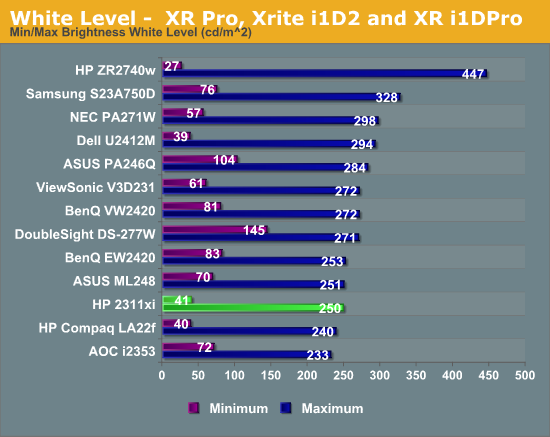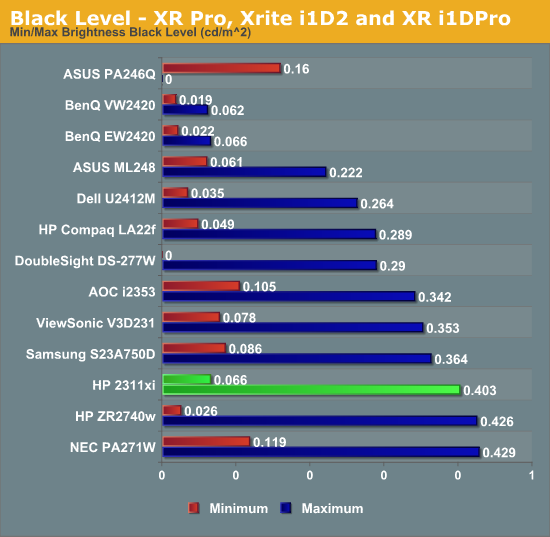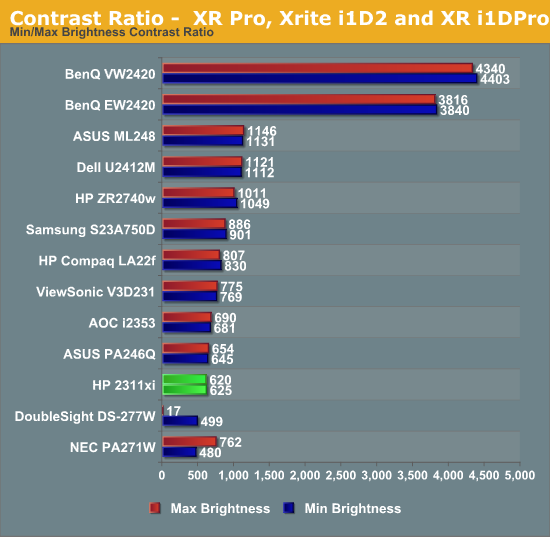HP 2311xi IPS Monitor
by Chris Heinonen on August 13, 2012 12:15 AM ESTHP 2311xi - Brightness and Contrast Ratios
HP rates the 2311xi for 250 nits maximum brightness and that’s exactly what I found it produced. If I turned the brightness all the way down it then put out only 41 nits, which gives you a lot of flexibility around adjusting the backlight level. 250 nits should be enough light output for most people, but if you have direct sunlight on your display for most of the day you might need something even more powerful to avoid it looking washed out.

For measuring the black levels, I made sure to leave the Dynamic Control off for the LEDs. With that enabled, it could potentially turn off the backlight completely, which would result in a black level of 0.000, but one that has no practical implications aside from a totally black screen. By leaving that disabled, we get a real-world measure of the black level. At maximum brightness, our black level is right around 0.4 nits, which is a little higher than other displays we have measured with similar peak white levels. The minimum level was 0.066, which correlates well with the white level change. Black levels are typically a little worse with IPS than with VA panels, which is the trade off for getting the other advantages an IPS display offers for color and viewing angles.

Looking at the contrast ratio, we are almost exact the same at minimum and maximum backlight, right around 620. I went ahead and measured this at 0-100% in increments of 10, and every measurement was between 620 and 625, so it’s a very consistent contrast ratio all across the range. It’s a perfectly normal and average contrast ratio, about what I’d expect from a budget IPS display.

Looking at the Brightness and Contrast numbers, the HP 2311xi is a decent but not exceptional performer. Nothing stands out, but everything about the performance so far is perfectly acceptable with the price involved.










68 Comments
View All Comments
eallan - Monday, August 13, 2012 - link
So we're comparing full blow laptops with great specs to monitors now?darwinosx - Monday, August 13, 2012 - link
Yeah pretty odd comparison. Also Apple laptop displays have gotten great ratings on this very website.Sabresiberian - Monday, August 13, 2012 - link
So you can't figure out he's just saying that there are high density monitors on the market already, and is just using the Apple Retina display notebooks as an example?piroroadkill - Monday, August 13, 2012 - link
There are very high res TFT-LCDs. Check out the IBM T220/1, 3840×2400, 22.2", back in 2001...Just a very small market for them, or at least there is perceived to be a very small market.
gegiarmo - Monday, August 13, 2012 - link
Why do so many companies refuse to put Displayport in such nice monitors? Does it really cost that much more to add in?jeremyshaw - Monday, August 13, 2012 - link
I'm guessing, but maybe they reused an existing controller PCB to shave costs. Or an older controller ASIC without DP, that was cheaper.Bull Dog - Monday, August 13, 2012 - link
yea honestly I started reading the article and saw, 'with no DisplayPort input' and I felt like not continuing to read any further. No DP input, no chance of my buying it or recommending someone else to get it. DP is the future, get with the times.Bull Dog - Monday, August 13, 2012 - link
but after finishing reading this review it does appear to be a nice monitor for $200.My sister purchased a Dell U2312HM for $240 back when Dell had it on sale. She is quite happy with it and for the little extra $$ you get a much more adjustable stand, Display Port, VESA mounts and matte black plastic.
tk11 - Monday, August 13, 2012 - link
You said it... "DP is the future" but the now is still dominated by DVI / HDMI.Senpuu - Monday, August 13, 2012 - link
A quick wiki search reveals that the first monitor with a DP port was released in January of 2008. Over the intervening years, it's gained rather widespread adoption, to the point that every modern GPU has a DP port. DP provides the most connection bandwidth of any standard, it's adaptable, and it's royalty free to incorporate into your monitor design. It seems a little silly at this point to exclude it from a new product.I'd say that DP is the present...